Moreton Bay is well known for producing a wide variety of fish and despite its proximity to one of Australia’s largest cities, it still holds a number of piscatorial secrets. One of those secrets is the ability of the bay to produce a whole smorgasbord of seafood, with no boat required!
At some stage of our lives, many of us move town or city and, as keen anglers, have to build up our local knowledge from scratch again. To help with this process we are blessed in this information age to have access to tools such as Google Earth, online fishing forums, fishing and weather apps and localised reports from magazines. But nothing beats time on the water – that, and shared local knowledge by joining local fishing clubs, or politely introducing yourself to locals on the water. Don’t expect instant ‘download’ of all the locals’ secrets, but if you build up trust and share some of your own experiences such locals may turn over some great secrets, which happened to me in Moreton Bay nearly 10 years ago.
As an ex-Canberran, I have fond memories from the 1990s and 2000s, wading the shallow entrances of southern New South Wales (NSW) estuaries such as Tuross, Brou Lake, Durras, and Dalmeny chasing a nice feed of prawns. We waded the shallows using prawn dip or scoop nets, an underwater light and towed behind us an over-inflated car tyre tube with a plasterers’ bucket inside it to store the prawns. It was great fun and very productive, but the season was limited to late October to mid-April, and only around the new moons. During these warm months of the year, many of these small coastal town estuaries looked like a Christmas tree on some weekend nights as families waded to and fro chasing a feed of prawns as they ‘ran’ with the outgoing tide.
Not long after moving to Brisbane’s bayside, I was surprised to learn that ‘prawning’ around Moreton Bay and surrounds was considered a ‘cast net from boats only’ option. While I had a boat, this didn’t sound as much fun to me, particularly the reports of wall-to-wall boats and ‘cast net rage’ at the more popular spots.
So it was with some surprise that one night as I was driving home when I spotted what looked like a couple of lights bobbing around in the shallows of the bay. My mind instantly turned to prawning, and so I ventured down to the water. Luckily enough I arrived just as the two gentlemen were returning from the water. There in their long prawn nets, were a couple of kilos of freshly caught prawns and some very big squid!
Fortunately for me, both gentlemen were in a generous mood and soon shared the how, what, where and when of prawning. It turns out one of them had been doing it for 20 years! I soon learnt the conditions for prawning in the Moreton Bay shallows are somewhat different to what I had been use to.
Instead of waiting for the prawns to come to you in waist deep water on the run-out tide like the south coast of NSW, these local bay and tiger prawns are much more dispersed and less active. Often these prawns can be caught sitting on the bottom around weedy areas, with sand or muddy bottoms. Another surprise was the prawns often sit in water, between little more than ankle to not much more than thigh deep. This means it is best to seek prawns at low tide in Moreton Bay. On high tide, the water is too deep, especially around bayside locations where the high tide comes right up to the rock walls.
As prawns in the Moreton Bay shallows can be found in concentrations or patches, sometimes this means wading several hundred metres in one night. As a result underwater lights, designed for lighting up relatively deeper water in smaller areas, are largely ineffective. Therefore, headlamps are the best option, to search around in the dark for the tell-tale sign of two red eyes. Sometimes, you get lucky and the bottom is lit up like a Christmas tree, but this is more the exception than the rule.
While some of the better headlamps on the market now, like the 10w Korr LED headlamps would be effective in this situation, they do chew through batteries left on for several hours. Therefore the best design is a DIY headlamp built into a cap and connected to a 12V battery. These headlamps are run from 12V 12Amp batteries that we carry around in a small backpack, along with a screwdriver and battery operated headlamp for any running repairs.
Other pieces of equipment you’ll need for prawning are two prawn scoop nets (available from tackle stores), thick-soled shoes, and a soft zip top esky to carry your prawns in. Waders are not necessary in summer and, in fact, the heavy soles from waders tend to stir the muddy bottom up, making it hard to see the prawns.
The Alvey dry pack is also a handy addition to carry any keys, phone etc, zipped up secure in your backpack, in case you need to place your backpack on the wet ground when changing batteries at any stage.
The trick with this method of prawning is using the two nets in tandem to maximise your success rate. [Note: Both Queensland Fisheries and Parks and Wildlife confirmed it is legal to use two scoop nets. The nets just need to be in your control, not staked, and their size must conform to the current regulations].
For prawns sitting on the bottom, this might come as some surprise, but the most successful technique is not to go head to tail, but rather, go at the prawn at a 90º angle. In other words, place the nets side on to the prawns’ body. The trick is to make sure you get close to the prawn and bring the nets together on the bottom quickly, and you will catch it in either net! Given the length of the scoop net you can then carry around a few caught prawns in the bottom of the net until you transfer them over to your cooler bag or esky you carry on your shoulder.
Best prawning times are from late November to the end of March in Moreton Bay. The key factors for a successful night are a hot day and still night so the water is not clouded by wind chop to see the prawns. A great guide for such conditions is www.seabreeze.com.au, which gives you up to date wind readings from a variety of locations is Moreton Bay. The other great thing about prawning the Moreton Bay shallows is it is not moon dependent. The prawns will be there, full or new moon.
Best time of tide is from about 2 hours before low to 2 hours after low. This means, based on the rule of twelfths for tides, you would be prawning in a maximum of 3/12 or 1/4 of the tide’s height. At this time the prawns are in the shallows and easily accessible.
Any of the shallow sand/mud flats with weed interspersed are worth a try, from Victoria Point to Wynnum North. This may be worth a try further north or south too.
Squid are another tasty seafood target accessible by wading the Moreton Bay shallows at night. Both tiger squid (northern calamari) and loligo squid (commonly known as arrows or pencil squid) are available. Tigers are known to grow to 1.5kg, while arrows reach around 100-200g each but are in much larger numbers and make for some awesome fresh mulloway or snapper bait or a fast feed.
Squid tend to gather around bottom structure during the day and spread out at night, coming to the surface to feed. Squid also like clear water, but unlike prawns, which move out to the deeper water in winter, mainland-based squidding is available in the cooler months, from late March to early November. In the warmer months, squid move out to the eastern bay in Moreton Bay as the northerlies regularly stir up the water. They can then be targeted on shore or by boat around the eastern bay islands like Straddie, Peel and Moreton.
While squid can be caught wading with headlamp and prawning gear as outlined above, more targeted techniques will deliver better results.
The good news for those wanting to hasten their learning curve on catching squid is Aaron and Paul from the Moreton Bay Squid Club, offer guided tours in the cooler months. The boys are a wealth of advice and suggest that squidding is best done from dawn to dusk, with best results as the high tide turns and starts to run-out, as long as the water is nice and clean, high visibility and not choppy, therefore the less wind the better.
The type of locations you want to look for squid are the edge of ribbon weed and sand. In terms of squid jigs, reputable quality jigs are proven to work better, with brands such as Yozuri and Diawa Nude Jigs in 3.5” in about 30-80cm of water.
The boys sight cast for squid along the waterfront using headlamps (anywhere where there is structure). They might also blind cast, with a simple technique: That is cast, let it sink, then 2 or 3 aggressive flicks, let it sink again, wait 20-30 seconds and repeat!
One of the tastiest surprises wading the flats for prawns over summer is to come across a mud crab either sitting outside its rocky or muddy burrow or paddling or ‘walking’ along the flats looking for food. You will be surprised by how many you might see. On one night alone I captured three legal bucks!
To capture the crab, again you can use one net to entice it into the other net. Another option is to place the butt on top of the crab and pick it up with your hands or spear it with sharp end of your prawn net, but you must be 100% it is a buck and legal first and I don’t recommend ‘crab wrangling’ to anyone not experienced in the art!
Before you go to the trouble of netting one though, you want to make sure you have a buck. Apart from the V-shape on the underside of their carapace, bucks have much larger claws. Once you’ve established it’s a buck, use your crab measure to ensure it is at least 15cm from point to point (in Queensland).
Likewise to ensure the crab has plenty of meat and not an empty shell, there are a few things you can look for. Don’t take a crab that has:
• A clean shell (i.e. free of growth or barnicles) and sharp ‘teeth’ on the claws;
• Any movement when you gently press the top of the shell;
• Any movement when you press the underside next to the second leg on either side of the body.
Another place to search for crabs is at the entrance to their rocky burrows. If you are lucky, you will spot one outside its burrow, and if quick enough with a net behind it, can scoop it up and measure it!
Wading around in the dark at night on your own means safety should also be a consideration. I’ve seen small sharks in the shallows, 2ft long at most, but have no intention to find out what might be lurking deeper than thigh deep! No prawn, mud crab, or squid is worth you being on the menu!
What’s more, make sure you wear thick rubber soled shoes, to avoid cuts from shells, oyster encrusted rocks, sticks or, worst still, glass fragments! Likewise, you will see a variety of rays, just give them their space and make sure you do not stand on one. A few other things will go bump against your leg in the night, they can give you a little fright but it is often nothing more than big whiting and bream. Expect the odd splash from a garfish on dead calm nights as well!
Anglers without a boat have plenty of choices for catching yummy seafood in Moreton Bay. What’s more, the availability of these tasty morsels is spread across the whole year! If that is not enough, as an added bonus you get great exercise wading the sand and mudflats while catching such a feast!
So whether you choose to wade the shallows in a beanie and jumper in winter or singlet in summer, there is a smorgasbord of seafood available at night right on Brisbane’s doorstep!
• If you’d like to read more unique fishing tips and reports from all around Australia, check out my family friendly virtual fishing club page www.facebook.com.au/onourfishingclub. Until next time, bag your mates – not your limit!
Moreton Bay Squid Club
Aaron operates out of Sandgate and fishes for squid around the Redcliffe Penninsula, while Paul operates out of Manly and fishes around Manly and Cleveland.
You can contact Aaron on 0411 644 214 or Paul on 0431 978 015 or their Facebook page www.facebook.com.au/Squidclub. A night with these lads is highly recommended and incredible value for money. The boys show you how, where and when to squid, and also how to clean and cook this yummy piscatorial delight!
Reads: 10336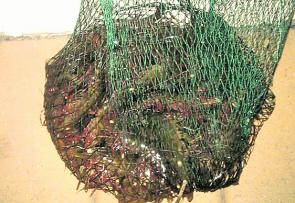
A decent haul of Moreton Bay tiger prawns caught wading.
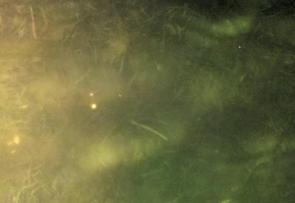
The tell-tale sign of two red prawn eyes.

You don’t need to spend a lot of money on fancy head lamps, this is an easy DIY prawning headlamp and batteries.

All the equipment you will need for prawning or crabbing on foot.
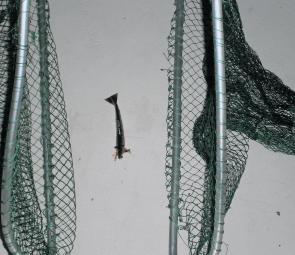
The best way to catch prawns off the bottom with two scoop nets either side.
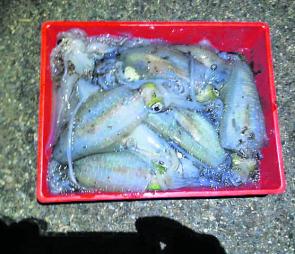
A nice haul of arrow squid.
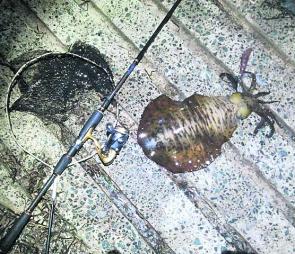
A big tiger squid caught on a jig.
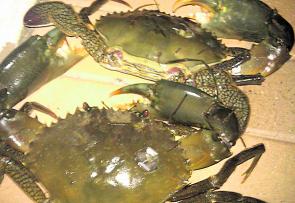
A couple of mud crabs caught while wading.




